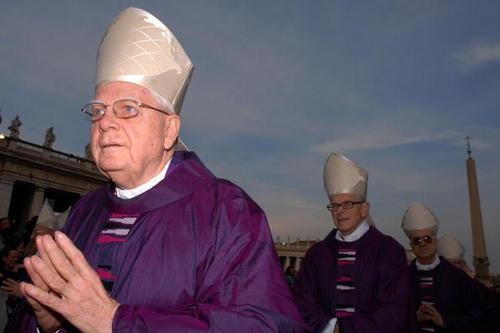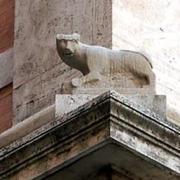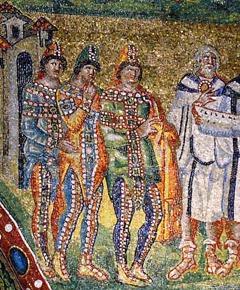
Rome is under siege these days. Prime Minister Silvio Berlusconi, always willing to assume the role of martyr, continues to claim that everyone is out to get him: the Communists, pinko magistrates (called “red togas” in Roman parlance), and the Left in general. Cardinal Tarcisio Bertone, Vatican Secretary of State, responding to the sudden torrent of sexual abuse allegations against the priesthood, says that everyone is out to get the Church and the Pope. Everywhere this spring, the open city seems to be sprouting new street barriers, or permanent guard posts, or at least a vanload of police.
Last summer, Berlusconi’s Roman residence, Palazzo Grazioli, was a party pavilion as porous to willing women as the White House proved to have been recently to the interloping Salahis. Now, however, the building looks more and more like the blinkered, bunkered US Embassy on the Via Veneto. The piazza behind Palazzo Grazioli used to be a parking lot, but recently the Prime Minister’s henchmen have set up a bulwark of concrete planters as if a car bomber were about to take aim (when the local traffic is mostly on foot, and consists of culture vultures bound for the glorious Doria Pamphilj Gallery next door, customers for the local library, and high school students from the nearby Liceo Visconti). The palazzo has always fronted on a bus stop—but this putative man of the people has kindly put an end to that public service. (The man has his own official residence, Palazzo Chigi, and there is no earthly reason that he has to live in this particular downtown palazzo; he just does, and expects the Eternal City to rearrange accordingly.)

The guardians at the Prime Ministerial gate once scolded me for standing with my back to Palazzo Grazioli and telling students about the fifteenth-century structure it faces, perhaps because that building, Palazzo Venezia, once housed the headquarters of Benito Mussolini—did they suspect that I might have been drawing parallels? To this date, fortunately, the Carabinieri at the back entrance have yet to apprehend me for pointing out the ancient Egyptian cat on a rearward cornice, a relic of the ancient temple to Isis that stood on this site.
That shrine was built almost two thousand years ago by another resident of Rome who knew that everyone was out to get him: the Emperor Domitian, a man so paranoid that he faced the walls of his residence with mirror-like mica, and slept in a subterranean bedroom carved deep into the Palatine Hill—where he was slain by the Praetorian Guard in 96 AD. Paranoids, as we know, may have good reason to be afraid.
Pedophiles, meanwhile, as Cardinal Bertone and many of his colleagues have been observing with alacrity of late, crop up more frequently in the population at large than they do in Sancta Romana Ecclesia; ergo there is no pressing need at this particular moment to discuss longstanding Vatican policies like that of priestly celibacy. Saint Peter had a family, to be sure, but that was a very long time ago. Emperor Domitian was a mere babe in arms.
In fact, however, the Church’s pedophile scandal already began to generate a siege mentality here in Rome six years ago (if not much earlier, as recent revelations from Ireland, Germany, and the United States suggest), when the former Archbishop of Boston, Cardinal Bernard Law, took up residence in Rome as titular cardinal of the ancient church of Santa Maria Maggiore after resigning from his position in the US, a step brought on by revelations of priestly abuse and his own reluctance to take action against it. The Cardinal’s new destination was no remote parish church; founded in the year 432, Santa Maria Maggiore was the first church dedicated in Rome to the Virgin Mary, and is one of the city’s four patriarchal basilicas—the most venerable and important of Rome’s four hundred-odd places of Christian worship.

Santa Maria Maggiore sits dramatically atop a spur of the Esquiline Hill, its curved apse enhanced by a Baroque cascade of steps that sweep up to its two back doors. In the 1970s, those doors stood open all day, every day, welcoming flocks of faithful pilgrims and tourists into the ancient sanctuary, where one priest even advertised hearing confessions in Esperanto. That feeling is long gone. Aluminum barriers have blocked the steps for years in fear that drunks might loll on them, proving that a blocked staircase creates a noticeable aura of decay far more effectively than a staircase full of motley humanity creates a public nuisance. The back doors of the basilica have been out of use for so long that one formerly open rear entrance has become a storage area for stacks of plastic chairs—right next to the tomb of the great artist Gianlorenzo Bernini and right beneath the fifth-century mosaics (fifth-century—the Roman Empire still existed!) that show the Three Kings in striped outfits as jaunty as any Swiss Guard’s.
Advertisement
The front of Santa Maria Maggiore has acquired a more permanent barrier, a metal fence installed by Cardinal Law to keep the beggars (and perhaps not only the beggars) away from the basilica’s doors; this is the only church in Rome where I have ever heard a priest yell, really yell, in a full-throated snarl, at a gypsy who must have tried to come within the fence. The atmosphere of Santa Maria Maggiore, once so full of joyous mystery, ranges from merely oppressive to downright nasty. Perpetual masses blare out from the seventeenth-century Pauline Chapel, and well they might, considering the burden of atonement the place now bears. My students and I were once rushed into the basilica’s gift shop as the basilica’s guards shut the doors behind us; when I asked what was happening, the answer was “Ci passa una messa”—“a Mass is passing.” In other words, as we were able to determine later, the cardinal formed part of the procession, and he wanted no disturbance.
Most cardinals walk around Rome freely, as Cardinal Ratzinger did, visibly, until his election as Pope. Cardinal Law clearly cannot walk in peace inside his own basilica. On the other hand, however acutely he may be suffering his own kind of imprisonment within Santa Maria Maggiore, that is no reason, for his sins, to transform a place designed to mimic Heaven on earth into a vision of Purgatory for everyone else. At the very least, there must be a closet somewhere in that vast building that can hold a stack of plastic chairs. And he might note that Prime Minster Berlusconi’s barriers all sprout palm trees. A little shrubbery on the ramparts helps to mask the brute reality of their presence. Now, however, with stories spreading about the abuse by priests, without effective Vatican intervention, of 200 deaf boys in Wisconsin and of choir boys in Germany, shrubbery may not be enough.

